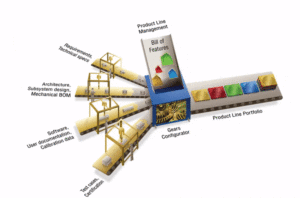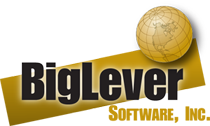In a product-centric environment, it’s common for the same engineering work to be repeated over and over – once for each product in the portfolio to which the work applies. Each time a new requirement is added, a software defect is corrected, or a test case is reworded, the same work must be applied to each product in turn. This duplication of effort is not only expensive but is mundane and low-value rather than innovative, high-value work.
No matter how efficient the product-centric engineering teams are, the inefficiency of applying changes product-by-product cannot be overcome – it’s a fundamental limitation of the product-centric approach. Scaling of products and their assets becomes untenable.
Feature-based Product Line Engineering (PLE) removes this limitation by focusing on the entire portfolio of products instead of the “siloed” approach that focuses on each product and each product’s engineering assets individually. When using PLE, the engineer only does the work once by updating the production line itself. The production line automation then applies the work to each of the affected products.

Not only does the Feature-based PLE approach reduce effort and increase value, but it also creates a single source of truth for variation in all engineering assets and a single source of truth to describe the characteristics that differentiate the products in the portfolio. The Features modeled in the PLE approach explicitly and precisely describe each product to the entire organization. Portfolio and product managers can now communicate unambiguously with engineers and vice-versa.
Using automation and precise shared language instead of engineering hours and sync-up meetings is the key to replacing low-value, error-prone work, with creative, high-value innovative work.
Product Line Environment Example
For example, we can compare the work required to remove a defect from the products in a portfolio. In the simplest, and least common case, the defect is simply fixed in the product in which it was discovered. However, if that defect was in code or requirements that were copied from another product – or if the defect was copied to other products – then comes the work of disseminating the fix to these other teams. The work required to fix the single defect is not simply the engineering work on the first product – it’s doing the impact analysis to discover which other products are affected and fixing them there as well. The total effort and cost grow exponentially with the number of products in the portfolio.
In a product line environment, all defects are fixed exactly once. They are fixed in the production line. The impact analysis is easily computed and the updated code or requirements for all products is easily generated. The defect is explicitly fixed for all products in a consistent manner and disseminated to consumers before they’re even aware the defect exists. This results in higher initial quality and reduced cost. How you spend these cost savings is up to you – engineers can fix more defects, add more features, or even roll out Feature-based PLE to other assets or product portfolios…
Higher Productivity Realized
Feature-based Product Line Engineering does not need to be adopted all at once in a big bang. It’s perfectly suited to incremental and low-risk adoption. PLE can be initially brought to bear where it has the most impact. The requirements team can convert their requirements to PLE before the software team… and if the software team isn’t ready, a requirements team for a different part of the portfolio can be rolled into the factory and start reaping the benefits straight away.
Business and engineering leaders are realizing remarkably higher productivity, lower overhead costs, shorter time to market, reduced workloads, higher quality, less chance for error by adopting PLE. This translates to a more diverse and innovative product line that more easily accommodates the rapidly changing product variations that the market demands.
The Feature-based PLE lifecycle solution breaks down organizational and operational silos enabling improved communication and alignment, more cohesion, and greater collaboration. Portfolio management, product planning, sales and marketing, supply chain management, and more are all within PLE’s ever-growing scope.
